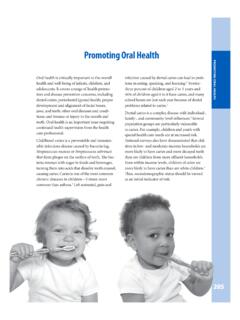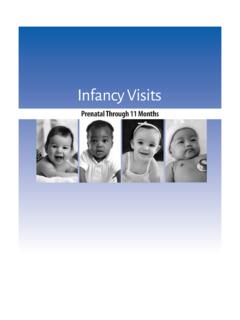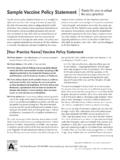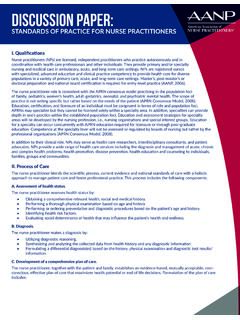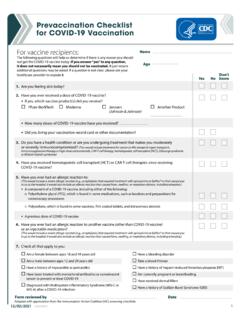Transcription of Template ADHD 100813 - Developmental-Behavioral Pediatrics
1 Document developed by Developmental-Behavioral Pediatrics Lucile Packard Children's Hospital at Stanford Last update 10/08/13 1 adhd Template IMPRESSIONS AND RECOMMENDATIONS ALL AGE VERSION SUMMARY: PTNAME is a XX-year-old boy/girl who came to the clinic to [restate chief concern and problematic behaviors]. PTNAME meets diagnostic criteria for Attention Deficit/Hyperactivity Disorder ( adhd ) based on the results of [ALL THAT APPLY: parent reports, parent and teacher behavioral rating scales, neuropsychological assessment, neurobehavioral testing and/or clinical observations. adhd is defined by core behavioral symptoms. PTNAME shows symptoms of inattention and/or hyperactivity and impulsivity. The diagnosis of adhd requires that the core symptoms are pervasive.]
2 The symptoms must be observed in at least two settings. We found that PTNAME has difficulties at home, at school, and in the community. The symptoms must be disruptive. Diagnostic criteria require that the child have functional problems. We found that PTNAME has difficulties with academic performance, peer relationships, family relationships, community participation, and/or community safety. The symptoms must be persistent. Diagnostic criteria require that they have been present for at least 6 months and began before the age of 7 years. The symptoms have been persistent in PTNAME. adhd has a neurobiological basis and is commonly inherited. In PTNAME s case, relatives XX--also have adhd . adhd is associated with other health conditions.
3 In PTNAME s case, he was born premature/has a genetic condition known as X/had congenital heart disease/was exposed to drugs and alcohol in utero/other. I/we considered several explanations for these behaviors. The history of repetitive rocking, spinning, and restrictive feeding can be seen in pervasive developmental disorder. PTNAME, however, is not impaired in language and social communication. HE/SHE interacts with social intent. HE/SHE has interest in reciprocal and pretend play. HE/SHE shows interest in peers and is motivated by praise. The rocking and spinning behaviors are likely related to the fidgetiness described by both PTNAME s teacher and mother. I found no evidence of anxiety, mood or tic disorders that could mimic adhd .
4 ] adhd is often accompanied by other conditions. In PTNAME, we found evidence of the following co-existing conditions: learning problems/disorders anxiety depression oppositional behavior conduct issues tics Though not a part of the diagnostic criteria, adhd is commonly inherited (20-25% incidence), which is likely the case for PTNAME. RECOMMENDATIONS: The recommendations for the treatment of adhd below are based on the 2011 American Document developed by Developmental-Behavioral Pediatrics Lucile Packard Children's Hospital at Stanford Last update 10/08/13 2 Academy of Pediatrics Clinical Practice Guideline for the Diagnosis, Evaluation, and Treatment of Attention-Deficit/Hyperactivity Disorder in Children and Adolescents.
5 This guideline is an outstanding source because it uses research studies in the medical literature to outline a plan of action. 1. adhd is a chronic condition likely to last many years, sometimes a lifetime. A team approach is necessary. Therefore, we recommend that you establish a medical home for your child. For most children, the child s primary care pediatrician or family physician serves as the medical home. The medical home collects all information on the child and assists the family with coordination of care. We will work with DR X as your medical home in establishing plans for the child. The PARENTS/FAMILY are members of the medical home team. 2. Treatments should focus on clear objectives on target outcomes. Target outcomes should be specific, measureable, reasonable, and attainable.
6 In PTNAME s case, together we discussed that the initial target outcomes will include the following [Adapt as appropriate]: a) PTNAME will follow directions with no more than two repetitions. b) PTNAME will complete 80% of class assignments without teacher intervention. c) PTNAME will remain at the dinner table with the family for 10 minutes. d) PTNAME will request toys from his brother using words and without hitting. 3. The main treatments for adhd are behavior management, educational interventions, and medication. Which treatments you choose depends on the child s age and characteristics, target outcomes, and community resources. Additional treatments may be needed for coexisting conditions. Choosing the treatments is an important decision for the family working together with the health care and educational teams.
7 3a. Parent- and/or teacher-administered behavior therapy is an important treatment for adhd . The main purpose of behavior therapy is to increase the child s motivation to improve attention and behavior and to encourage strategies that increase behavior control and regulation. Behavioral therapy varies widely in scope and technique. Here are some tactics used in behavior management: a) Use effective rewards to increase desired behaviors b) Use planned ignoring to reduce or eliminate undesirable behaviors c) Provide appropriate consequences if the child does not meet the goals d) Apply rewards and consequences as consistently as possible e) Gradually increase expectations for each task as they are mastered f) Change rewards and consequences as necessary to keep the child s motivation high Behavior management is often difficult for parents of children with adhd to implement on their own.
8 Therefore, we recommend that parents seek community services for parent training and for support. We provided PARENTS with contact information of several individual therapists and community agencies in the community near their homes. [LIST specific referrals.] 3b. Behavioral therapy programs at schools use the same approaches as those described above. In addition, school programs typically include accommodations for the child to facilitate implementation and child success. Here are some accommodations for school: a) Preferred seating in the classroom near the teacher b) Reduced work assignments c) Planned breaks after periods of intense concentration d) Opportunities to take tests in quiet non-distracting locations Document developed by Developmental-Behavioral Pediatrics Lucile Packard Children's Hospital at Stanford Last update 10/08/13 3 e) Small group activities f) Increased teacher input to the child regarding behavior g) A Daily Report Card providing parents with detailed information about the child s success or difficulties during the school day.
9 A 504 Rehabilitation Act Plan or special education Individual Education Program (IEP) under the other health impairment designation of the Individuals with Disability Education Act (IDEA) is often helpful to implement and support a behavior management program, accommodations, and specialized instruction at school. In PTNAME s case, I recommend a 504 plan. A Template letter was provided to PARENT to request a 504 plan from PTNAME s school district. Consent was obtained to communicate with PTNAME's teachers who can be valuable observers of how a child functions in the school/classroom setting. In PTNAME s case, I recommend HE/SHE be evaluated for special education. A letter was provided to the PARENT to request that the school district initiate the evaluation.
10 I encouraged PARENT to share this letter with the school district to be included in the evaluation. 4. Strong evidence supports the use of stimulants at optimal doses to control core symptoms of adhd . Measured targeted outcomes (as described above) and behavioral rating scales help assess the level of symptom control. Parents must with a plan to use medication. 4A. I recommend a trial of stimulant medication to treat the core symptoms of adhd and to contribute to the plan to achieve target outcomes. PARENT concurred with this plan a) Ritalin LA (long-acting) at 10 mg once daily in the morning or b) Concerta (or its generic equivalent) at 18 mg once daily in the morning I provided PARENT with handouts on potential benefits and side effects of medication.
